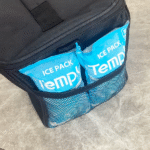Envío de bolsas de hielo seco en 2025: Cómo garantizar una logística de cadena de frío segura y eficiente
El envío de mercancías sensibles a la temperatura requiere una planificación cuidadosa, especialmente cuando se utiliza hielo seco para mantener temperaturas bajo cero. En esta guía, Exploraremos cómo funcionan las bolsas de hielo seco., sus aplicaciones en diversas industrias, precauciones de seguridad, y como el 2025 El panorama de la cadena de frío está evolucionando para satisfacer las necesidades modernas del transporte marítimo..
-
¿Cómo funcionan las bolsas de hielo seco?, y ¿por qué son cruciales para el envío??
-
¿Cuáles son los principales usos de las bolsas de hielo seco en diferentes industrias??
-
¿Qué precauciones de seguridad se deben seguir al manipular hielo seco??
-
Cómo es entrega de hielo seco evolucionando en 2025?
¿Cómo funcionan las paquetes de hielo secos?, y por qué son esenciales para el envío?
Las bolsas de hielo seco son una forma de dióxido de carbono solidificado. (Co₂) que se sublima directamente de sólido a gas a -78,5°C (-109.3°F), haciéndolos esenciales para mantener los productos congelados durante el envío. A diferencia del hielo normal, que se derrite y puede causar daños relacionados con la humedad, Hojas de hielo seco no residuos, garantizar que productos como las vacunas, alimento, y las muestras biológicas permanecen secas y frías durante el transporte.
Por qué el hielo seco es más eficiente que el hielo normal
-
Sin humedad: El hielo seco previene el daño por humedad al sublimarse en gas en lugar de fundirse en agua..
-
Duración más larga: Puede mantener temperaturas bajo cero durante mucho más tiempo que el hielo normal..
-
Retención superior del frío: El hielo seco mantiene una temperatura extremadamente baja., Lo cual es crucial para productos como vacunas y alimentos congelados..
Principales usos de las bolsas de hielo seco en diversas industrias
Envíos farmacéuticos y médicos
En la industria farmacéutica, El hielo seco es indispensable para enviar artículos sensibles a la temperatura, como vacunas y productos biológicos.. Muchas vacunas, como los utilizados para COVID-19, requieren temperaturas bajo cero durante el tránsito. El hielo seco garantiza que estos productos permanezcan dentro del rango de temperatura requerido..
Industria alimentaria
El hielo seco también es fundamental en la industria alimentaria. Se utiliza para enviar productos perecederos., incluyendo alimentos congelados, mariscos, y helado. La retención de frío del hielo seco ayuda a mantener la frescura y evitar el deterioro durante el transporte de larga distancia..
Biotecnología y envío científico
Las empresas de biotecnología y los laboratorios de investigación dependen del hielo seco para enviar muestras biológicas y productos químicos sensibles. El hielo seco ayuda a mantener la integridad de los materiales científicos al proporcionar una solución de enfriamiento estable y confiable durante el envío..
Consideraciones de seguridad al manipular hielo seco
hielo seco, mientras que es extremadamente eficaz como agente refrescante., puede presentar riesgos si se maneja mal. Aquí están las pautas de seguridad esenciales.:
-
Utilice equipo de protección: Utilice siempre guantes aislantes para evitar la congelación..
-
Asegurar una ventilación adecuada: Dado que el hielo seco se sublima en CO₂, Una ventilación adecuada es crucial para evitar la asfixia en espacios cerrados..
-
Almacenamiento y embalaje adecuados: Guarde el hielo seco en recipientes ventilados para evitar la acumulación de presión y evite el uso de envases herméticos..
Ejemplo del mundo real: Una empresa de logística tuvo problemas al utilizar contenedores herméticos para hielo seco, lo que provocó una explosión durante el tránsito. El uso de envases ventilados podría haber evitado este problema.
Tendencias en la entrega de hielo seco para 2025
Creciente demanda de soluciones ecológicas
La sostenibilidad se ha convertido en una tendencia clave en la logística, Muchas empresas exploran alternativas ecológicas al hielo seco tradicional.. Esto incluye bolsas de hielo seco biodegradables y métodos de captura de carbono que reducen la huella ambiental del transporte marítimo..
Sistemas avanzados de seguimiento y monitoreo
2025 está viendo un mayor uso de sistemas de seguimiento en tiempo real para envíos de hielo seco. Estos sistemas permiten a las empresas monitorear el estado de sus productos durante el tránsito., asegurándose de que permanezcan dentro del rango de temperatura necesario.
Innovaciones en contenedores de envío de hielo seco
Los nuevos desarrollos en contenedores de hielo seco aislados y eficientes están ayudando a reducir la cantidad de hielo seco necesaria para los envíos., reduciendo tanto los costes como el impacto medioambiental.
¿Cuánto hielo seco realmente necesitas??
La cantidad necesaria de hielo seco depende de varios factores., como el peso del producto, Duración de envío, y condiciones ambientales. Una pauta general es utilizar 5 a 10 libras de hielo seco por período de tránsito de 24 horas. Para cálculos más precisos, A menudo se utiliza una fórmula.:
Hielo seco requerido (lb) = Peso del producto (lb) × 0.6 × días de tránsito × factor de temperatura.
Por ejemplo, enviar un kit de comida de 20 libras durante dos días a -20°C requeriría alrededor de 31 libras de hielo seco.
Embalaje y envío con hielo seco
El embalaje adecuado garantiza que el hielo seco funcione de manera eficiente durante todo el tránsito.. He aquí cómo hacerlo:
-
Elija el contenedor correcto: Utilice cajas aisladas o refrigeradores para mantener las bajas temperaturas..
-
Preparar el hielo seco: Asegúrese de colocarlo en un recipiente ventilado para permitir la sublimación..
-
Empacar el producto: Rodee su producto con hielo seco para mantener un enfriamiento constante.
-
Etiqueta y sello: Asegure el contenedor y etiquételo claramente con las marcas apropiadas para materiales peligrosos..
Regulaciones de envío
Los envíos de hielo seco están regulados por varias organizaciones., incluyendo el A NOSOTROS. Departamento de Transporte (PUNTO) y el Administración Federal de Aviación (FAA) para transporte aéreo. Asegúrese de seguir todos los embalajes., etiquetado, y requisitos de documentación para garantizar el cumplimiento.
El costo de la entrega de hielo seco
El envío de hielo seco tiene varios costes, incluidos los gastos de envío y el precio por libra. Aquí hay un resumen de los servicios de entrega típicos.:
| Tipo de proveedor | Gama de precios | Orden Mínima & Honorarios | Mejor para |
|---|---|---|---|
| Recogida local | $1.50–$3.15 | No menos importante | Pequeñas cantidades para uso personal. |
| Minoristas en línea | $0.60–$1.50 | Mínimo 10 lb | Envío de comercio electrónico |
| Servicios de emergencia | Varía | Sin mínimo fijo | hospitales, centros de datos |
| Proveedores industriales | $2.25 por libra | Mínimo 5 libras | Laboratorios, fabricación |
Estrategias de ahorro de costos
-
Ordene la cantidad correcta: Evite realizar pedidos excesivos para minimizar el desperdicio.
-
Comparar recogida vs.. Entrega: Para cantidades más pequeñas, la recogida local puede ser más barata.
-
Pedidos al por mayor: Pedidos grupales con otras empresas para recibir tarifas con descuento.
Preguntas comunes
Q1: ¿Cuál es la diferencia entre hielo seco y hielo normal para envíos??
El hielo seco es mucho más frío y se sublima formando gas., mientras que el hielo normal se derrite en agua, que puede dañar los productos.
Q2: ¿Se puede utilizar hielo seco para envíos internacionales??
Sí, pero existen regulaciones específicas sobre la cantidad y los requisitos de embalaje para envíos internacionales de hielo seco..
Conclusión y consejos prácticos
Las bolsas de hielo seco son esenciales para garantizar el transporte seguro de mercancías sensibles a la temperatura. Seleccionando el formulario correcto, calculando la cantidad requerida, y respetando las normas de seguridad, las empresas pueden garantizar la seguridad, rentable, y una logística eficiente de la cadena de frío.
Siguientes pasos:
-
Evalúa tus necesidades: Calcule la cantidad de hielo seco necesaria para su envío.
-
Elija el paquete adecuado: Selecciona el mejor formato de hielo seco para tu producto.
-
Elija un proveedor: Compara precios y servicios de varios proveedores..
-
Priorizar la seguridad: Siga todas las pautas de seguridad al manipular hielo seco..
Acerca de Tempk
Tempk se especializa en soluciones personalizadas de cadena de frío, incluyendo hielo seco, paquetes de gel, y transportistas aislados. Brindamos asesoramiento experto, formación regulatoria, y estrategias de entrega para industrias como la farmacéutica, alimento, y biotecnología. Contáctenos hoy para optimizar la logística de su cadena de frío.























